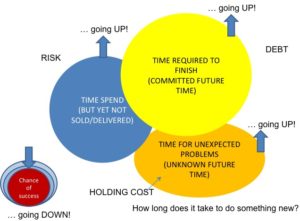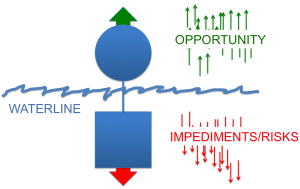How agile is your organization? How agile could it be? How agile should it be?
I believe that agility must be observable and is relative to your business context.
Every business runs at a certain pace. Being agile at the organizational level means being able to move and navigate at that pace – you need to be able to manage at the speed you can afford to lose. It means reducing the risk that what you have done until now locks you in and prevents you from doing what you want going forward.
The fundamental questions for any business is: 1) how much have you done and not yet delivered? 2) how much time and effort would it take you to complete and deliver what you have already started – if you did nothing else? 3) How easy is it to do the new things you want to do?
The first question is your risk exposure. What you have done will not change, but what the customer wants may. Until you have delivered you are at risk of things changing.
The second question is your future commitment – future time and money allocated to fulfilling existing commitments. Meaning that you cannot do something new before that is delivered – in principle at least. The larger the commitment, the less agile you are.
This is essentially what defines your agility at a portfolio level – at what pace and at what risk level can you make adjustments when required by – or favorable for – your business – are you as agile as required? Or, just how agile are you?
In an ever changing world, the more you have done and the more you still have to do, the more you are likely to experience unforeseen problems and the less likely you are to succeed as you have planned/hoped.
Having limited opportunity to act means being less agile.
The essence of agility is managing at the speed you can afford to lose. (Or, if you have deep pockets, at the speed it makes sense to lose :))
==> Managing – controlled risk taking
==> Speed – balancing load to capacity so you can move as required
Business agility is agility at the tactical level of the organization – the level where strategies, budgets, organizational designs and are execution plan meet. It’s a very different area of concerns than the ones of introducing agile practices in a team.
Agility is synonymous with sustainable value flow and the ability to explore new opportunity when relevant. I.e. not being locked up in your own process and victim of building on the wrong ideas.
The third question above is a steady state question. How locked are you in terms of implementing new things? The more effort required, the riskier it is cf. the above arguments.
=== Why?
Important to understand what level of agility is required for your business: how agile do you need to be and why? How agile are you?
Agility is required to overcome risks and impediments and be able to take advantage of new opportunity. This can be illustrated like this:
Often you see organizations just struggling to stay above the waterline – to survive. But actually the sky is the limit – the opportunity is endless; your capacity to explore it not … still you want to stay far above the waterline and be constrained only by your capacity to explore:
Agility – your ability to act – is what prevents you from falling over when facing impediments or exposed to risks turning into actual problems. And similar agility is what enables you to change and re-prioritize when new opportunity emerge. Agility allows you to absorb the unexpected and adjust for the best outcome – at the pace required by your business context.
=== Strategy execution
The questions of how to ensure that strategies are actually executed is one of the hottest topics in today’s business environment. You see it covered under topics like ‘portfolio Kanban’, ‘agile PMO’ or similar.
Under #AgileSpark I propose how you can get started and it’s the key topic of #TheNeedForSpeed. Also check out ‘#WMM – winnable mission management’, #MakingWinnable and #GreenWaving.
=== Public presentations
XP2016, May-2016
XP2015, May-2015
Workshop topic, Tecpoint, Feb-2015



